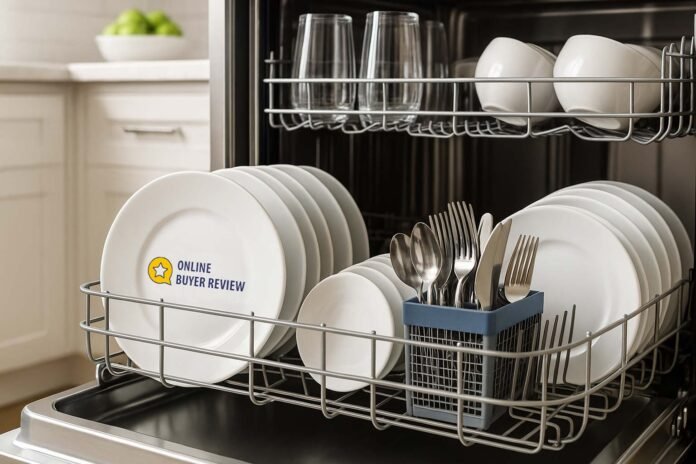Want spotless dishes every time? Learn how to load a dishwasher the right way with our expert guide—plus must-have accessories for better cleaning performance.
Why Proper Loading Matters
Loading your dishwasher the correct way isn’t just about organization—it’s essential for optimal performance. Here’s why it matters:
- Cleaner dishes: Proper spacing ensures spray arms reach every item.
- Longer appliance life: Avoiding blocked arms and overloading prevents wear.
- Lower utility bills: Efficient cycles use less water and energy.
- Better hygiene: Prevents buildup of residue and bacteria.
What to Know Before You Load a Dishwasher the Right Way
Before you start loading, keep these foundational tips in mind:
- Read your manual: Every dishwasher model has unique rack designs and spray arm locations. Check the user guide for best practices.
- Understand spray zones: Spray arms are most powerful in specific areas—arrange items accordingly.
- Choose the right detergent: For example, in hard water areas, specialized detergents can make a big difference. Check our guide on the Best Dishwasher Detergents for Hard Water in 2025.
Step-by-Step: How to Load a Dishwasher the Right Way
1. Scrape, Don’t Rinse
Remove large food debris with a spatula or fork. Don’t pre-rinse—modern dishwashers are designed to clean effectively with some residue.
2. Load Bottom Rack the Right Way
- Place plates vertically, facing the center.
- Pots and pans should go at an angle for better spray access.
- Avoid stacking and ensure nothing blocks the spray arms.
3. Load Top Rack Properly
- Place cups and glasses upside down.
- Bowls should tilt slightly to allow water drainage.
- Place plastic items only on the top rack to avoid warping.
4. Where to Place Utensils
- Use the utensil basket or third rack.
- Mix utensils to prevent nesting (e.g., alternate spoons and forks).
- Sharp knives should go blade-down or in a separate compartment for safety.
5. Don’t Overload
- Leave space between dishes.
- Avoid nesting and crowding.
- Overloading compromises spray reach and detergent flow.
6. Use Rinse Aid and the Right Cycle
- Use rinse aid to prevent spots and improve drying.
- Choose cycle based on the soil level—use “Heavy” for pots, “Normal” for daily loads.

Common Mistakes When Loading a Dishwasher the Wrong Way
- Nesting utensils that block spray access.
- Overfilling the racks.
- Placing non-dishwasher-safe items, like wood or insulated mugs.
- Blocking the detergent dispenser or spray arms.
Learn more in our guide: What Not to Put in a Dishwasher 2025 Guide
Recommended Dishwasher Accessories for Better Results
Upgrade your dishwashing game with these tried-and-true tools:
Best Dishwasher-Safe Utensil Basket Replacement
💡 Keeps silverware organized and rust-free. Great for older dishwashers. Check Price on Amazon
Adjustable Dishwasher Racks for Tall Items
💡 Maximize interior space and fit larger cookware with ease. Shop on Amazon
Best Rinse Aid for Spot-Free Finish
💡 Especially useful in hard water regions like Arizona or Nevada. See on Amazon
Final Tips for Dishwasher Maintenance
- Clean the filter weekly to prevent clogs.
- Run a vinegar rinse monthly to eliminate odors and buildup.
- Leave the door ajar after a cycle to reduce moisture and mold.
FAQs
Q: Should I rinse dishes before loading the dishwasher?
A: No. Scraping is enough. Rinsing wastes water and can interfere with detergent performance.
Q: How do I prevent plastic from melting in the dishwasher?
A: Always load plastics on the top rack, away from the heating element.
Q: Why are my dishes still dirty after running a full cycle?
A: Common causes include overloading, blocked spray arms, or a dirty filter.
Conclusion
Loading your dishwasher the right way saves time, energy, and frustration. Follow these simple steps and avoid common mistakes to keep your dishes spotless.
Want even better results? Try our top-rated dishwasher accessories and make every cycle count.





